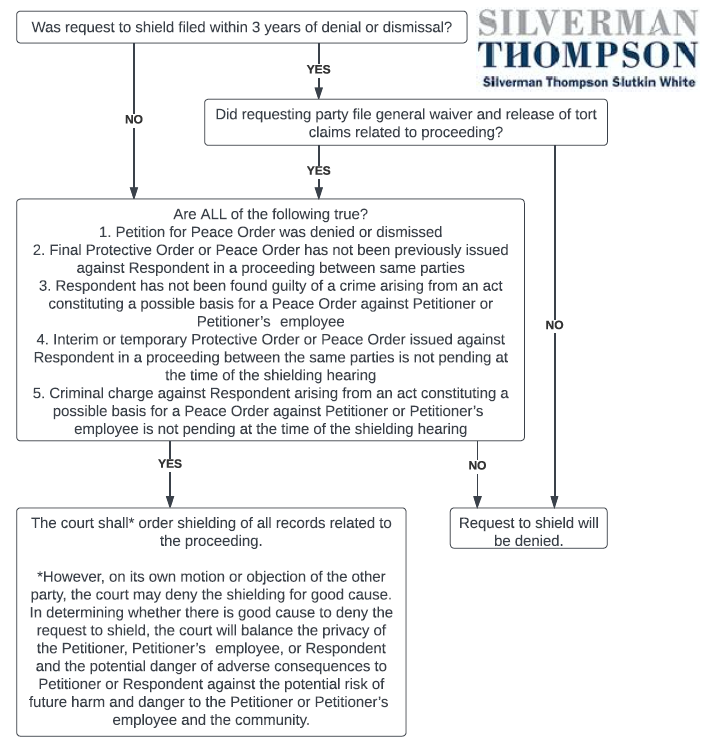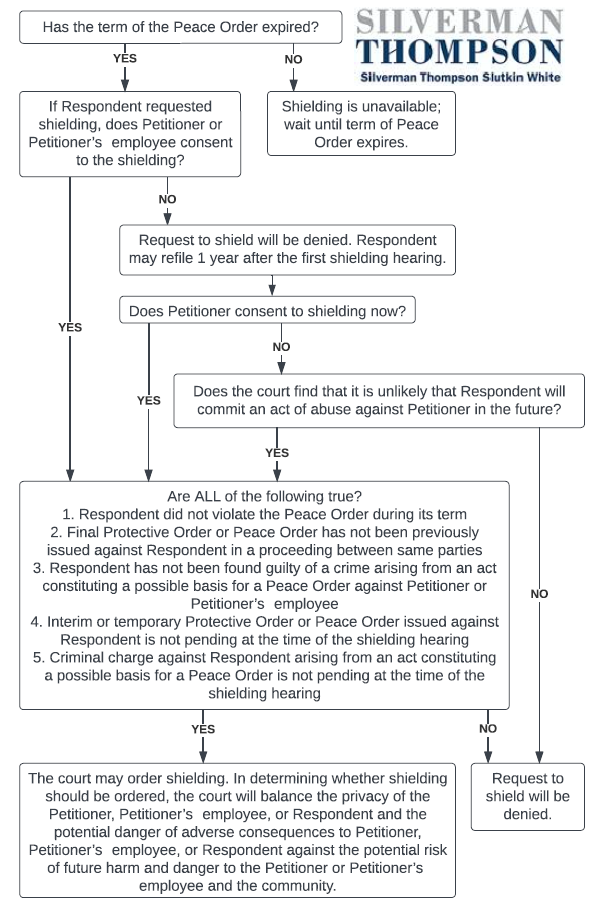Who are the parties in a Peace Order proceeding?
In a Peace Order proceeding, the person who filed a Petition for Peace Order is called the “Petitioner,” and the person against whom the Petition was filed is called the “Respondent.”
What acts can be grounds for a Peace Order in Maryland?
A person can file a Petition for a Peace Order based on any of the following acts:
- An act that causes serious bodily harm;
- An act that places the Petitioner or Petitioner’s employee in fear of imminent serious bodily harm;
- Assault in any degree;
- False imprisonment;
- Harassment;
- Stalking;
- Trespass;
- Malicious destruction of property;
- Misuse of telephone facilities and equipment;
- Misuse of electronic communication or interactive computer service;
- Revenge porn; or
- Visual surveillance.
Are Peace Order records open to the public?
In Maryland, most court records are open to the public. Records of Peace Order proceedings are included among the types of records that are open to the public.
A Peace Order can cause serious collateral consequences for the Respondent, such as difficulties in seeking employment or obtaining a lease. However, Maryland law allows records of Peace Order proceedings to be shielded in certain circumstances.
What is a court record?
The court record of a Peace Order proceeding can include an index, docket entry, petition, memorandum, transcript, electric recording, judgment, and any electronic information about the proceeding on the Maryland Judiciary Case Search website.
What is shielding?
Shielding means that the records are removed from public inspection. Shielding of the court records of a Peace Order proceeding does not destroy or erase the records. Shielding does not remove information about the proceeding from the Domestic Violence Central Repository.
For physical records kept in a courthouse, shielding means moving those records to a separate secure area that can only be accessed by someone who has a legitimate reason to access the records.
For electronic records, shielding completely removes all information about the Peace Order proceeding from the Case Search website. This includes the case number, parties’ names, any reference to the Peace Order proceeding, and any reference to the removal of the Peace Order proceeding from the Case Search website.
Who can access a shielded record of a Peace Order proceeding?
For a legitimate reason, a law enforcement officer, an attorney who represents or has represented the Petitioner or the Respondent, a State’s Attorney, an employee of a local Department of Social Services, or a victim services provider can access a shielded record.
Other persons may subpoena or file a motion for access to a shielded record. The court may grant access to a shielded record if the court finds that the requestor has a legitimate reason to access the record. In considering such a request, the court must balance the requestor’s need for access to the record with the parties’ right to privacy and the potential harm of unwarranted adverse consequences to the parties that may be created by the disclosure of the shielded record.
Who is eligible to shield a Peace Order?
The Petitioner, Petitioner’s employee, or Respondent may file a request to shield the court records related to a Peace Order proceeding.
Records related to a Peace Order that was denied or dismissed at the interim, temporary, or final stage are eligible for shielding.
If the Respondent consented to the entry of the Peace Order, the records related to the proceeding are eligible for shielding.
If a Final Peace Order was entered after a contested hearing, records related to the Peace Order proceeding are not eligible for shielding.
When can I file a request to shield Peace Order records?
If the Peace Order was denied or dismissed, a request to shield can be filed 3 years after the denial or dismissal. The requestor can skip this 3-year waiting period if the requestor files a general waiver and release of all tort claims related to the proceeding.
If the Respondent consented to the entry of the Peace Order, a request to shield can be filed any time after the expiration of the Peace Order. If the request to shield was filed within 3 years of the consent to the entry of the Peace Order, the requestor must file a general waiver and release of all tort claims related to the proceeding.
What is the process when a request to shield is filed?
When a request to shield records of Peace Order proceedings is filed, the court will schedule a hearing on the request to shield and will give notice of the hearing to the other party or the other party’s attorney of record.
Flowchart: Shielding of denied or dismissed Peace Orders
The following flowchart explains the considerations that the court will apply to a request to shield the records related to a Peace Order that was denied or dismissed at the interim, temporary, or final stage.
Flowchart: Shielding of Peace Orders entered by consent
The following flowchart explains the considerations that the court will apply to a request to shield the records related to a Peace Order that was entered by the Respondent’s consent.
Navigating the court system can be a difficult and stressful process. If you are considering trying to shield records related to a Peace Order proceeding, we encourage you to speak to an experienced family law attorney at Silverman Thompson who can assist you in navigating the process from start to finish.
For more information, contact Monica Scherer, Esq. at 410-625-4740.
Disclaimer: This blog is informative in nature. The information contained herein is not to be considered legal advice and there is not an attorney-client relationship formed between Silverman Thompson and the reader. The materials in this blog cannot be repurposed without the permission of Silverman Thompson.
 Maryland Divorce Lawyer Blog
Maryland Divorce Lawyer Blog



